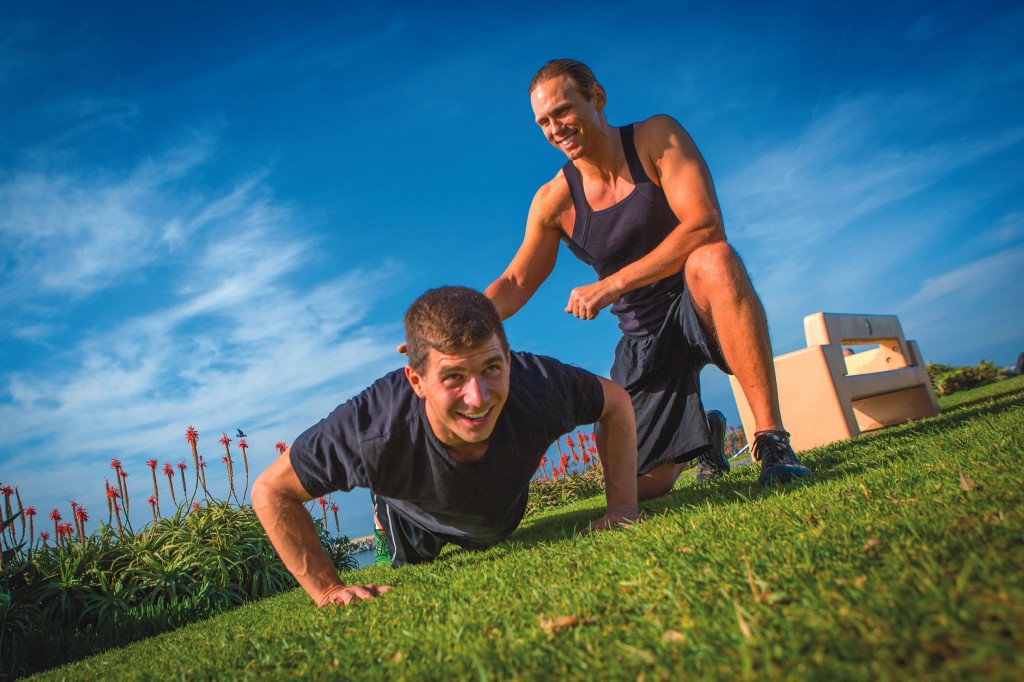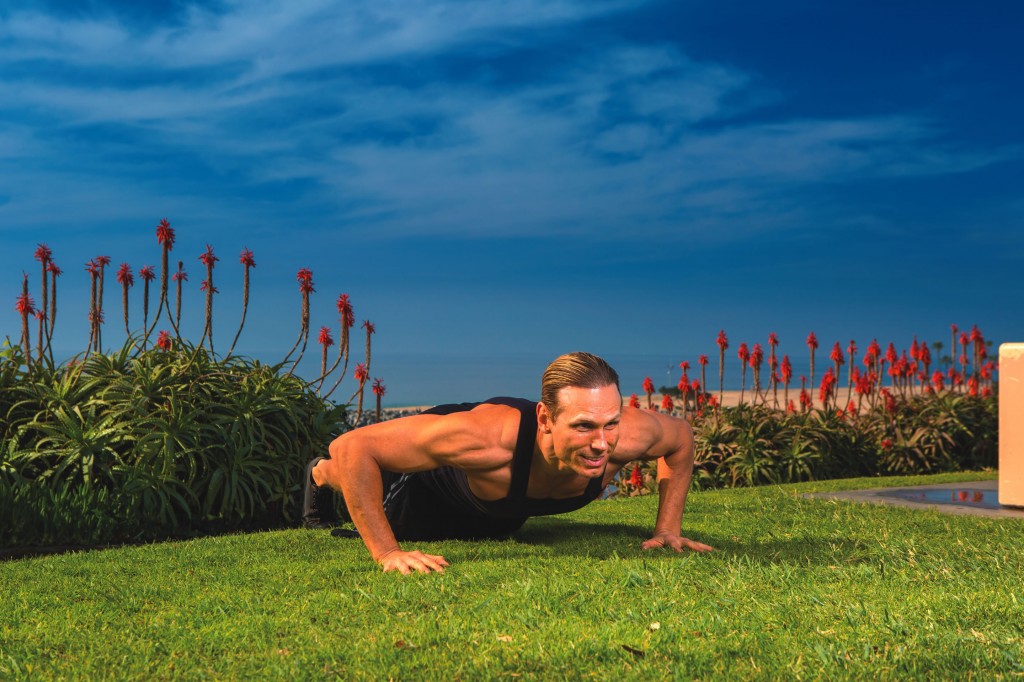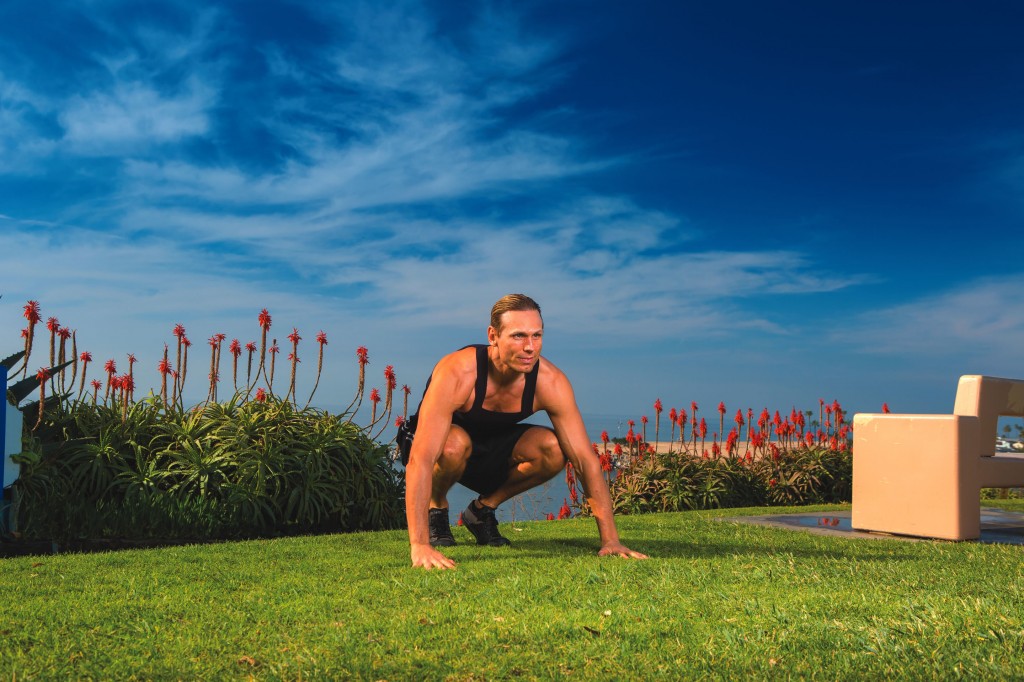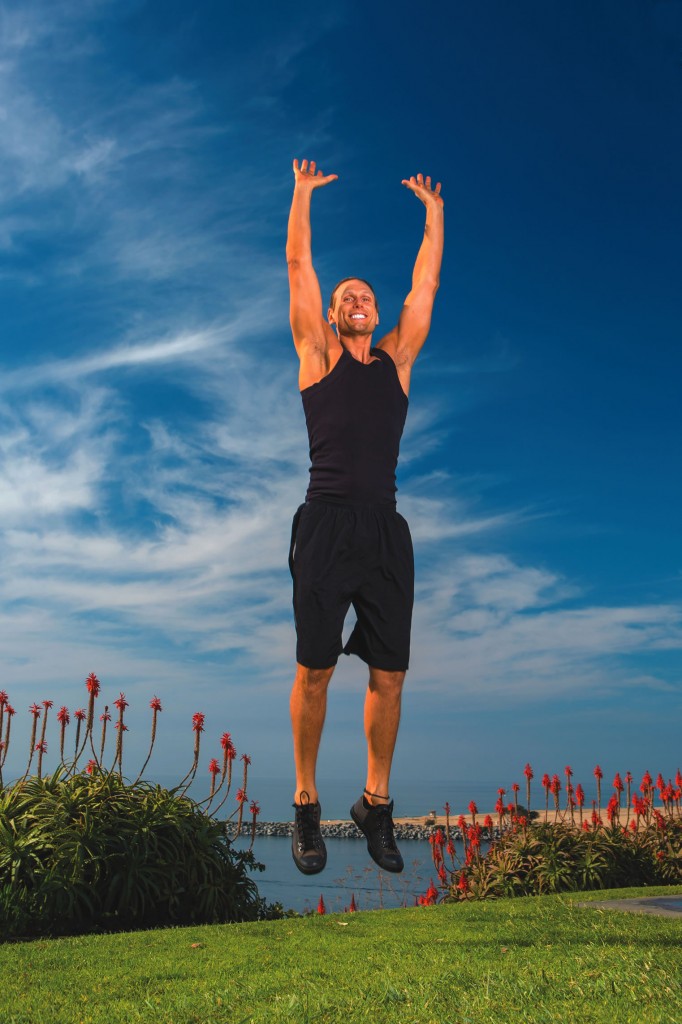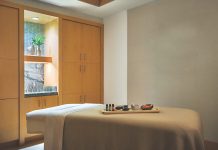Newport men can start the new year fresh with a classic workout routine that targets major muscle groups and builds strength, not bulk.
By Peter A. Balaskas
There’s more to working out than just having a six-pack and rippling muscles the size of tree trunks. Although the final results exude sentiments of pride, the journey toward such goals is equally admirable. Fitness aficionados know too well the feeling of blood surging through the biceps while performing simple pullups, the slow burn coursing along the abdominal muscles approaching the 100th consecutive stomach crunch, the stimulating expansion of the pectorals while bench-pressing increased weight with each repetition and, finally, the intense stretch in the glutes when executing a series of aggressive squats.
There has been a movement recently among male athletes and trainers who choose these basic core workouts over the newer, more complex social exercise programs. Though all forms of exercise can be fun and enjoyable, there’s something to be said about the simplicity and convenience of a workout that strips fitness down to its most uncomplicated form.
Unbiased to beginners or professional athletes, nailing down a basic exercise routine not only improves the physical form, it also enhances a man’s mental and emotional well-being, resulting in an overall healthy lifestyle.
The First Steps
The biggest challenge for anyone starting a basic workout program is simply getting started, as sometimes the mere thought of exercising at all can be extremely daunting for men more used to donning business suits than track suits. Reasons for delaying any kind of regular exercise program could range from idleness to the fear of experiencing the uncomfortable yet “good” pain associated with flared muscles and a racing heart rate.

Ryan Campbell, a physical trainer at Equinox Newport Beach, asserts the most common reason for the reluctance to develop a routine is the time required to invest in mentally training the brain for exercise.
“This can be solved by committing to 20 minutes or some denomination of time you can [handle],” he says. “This will help create the habit and once you begin to feel better [about each workout], it is amazing how easy it is to spend a couple extra minutes exercising.”
Some tricks he suggests to jump-start a new regimen include working out first thing in the morning before heading in to the office; being prepared by keeping gear in the car; joining a gym that’s between work and home; and combining business and fitness by reviewing work materials during cardiovascular exercises.
Once a person decides to commit to a basic workout program, one of the most important initial steps is to understand what your body is capable of handling. Before launching into any new routine, most trainers recommend undergoing an assessment that will set goals and limitations to achieve optimum performance. Brian Keith Bias, a fitness consultant at Curl Fitness in Newport Beach, says that any reliable workout begins with the background of the man who is beginning the program, including his age, goals, career and work schedules, and exercise and medical history.
The assessment could take the form of a physical activity readiness questionnaire—checking all baselines such as cardiovascular and core endurance, blood pressure, resting heart rate, body composition and strength, among many others—which is the first part of Ryan’s three-step client process. He also has clients perform fundamental movement patterns as a second step, testing their ability to handle basic moves like squats, deadlifts, lunges and an upper body push/pull.
Other trainers, like Steve de la Torre of Personal Training Revolution in Corona del Mar, also take a physical approach. Steve chooses to guide his beginner clientele through an initial baseline fitness test, which includes a timed quarter-mile run for speed and one minute of pushups, squats and pullups. The final component of the fitness test is a timed plank hold to test core endurance and strength.
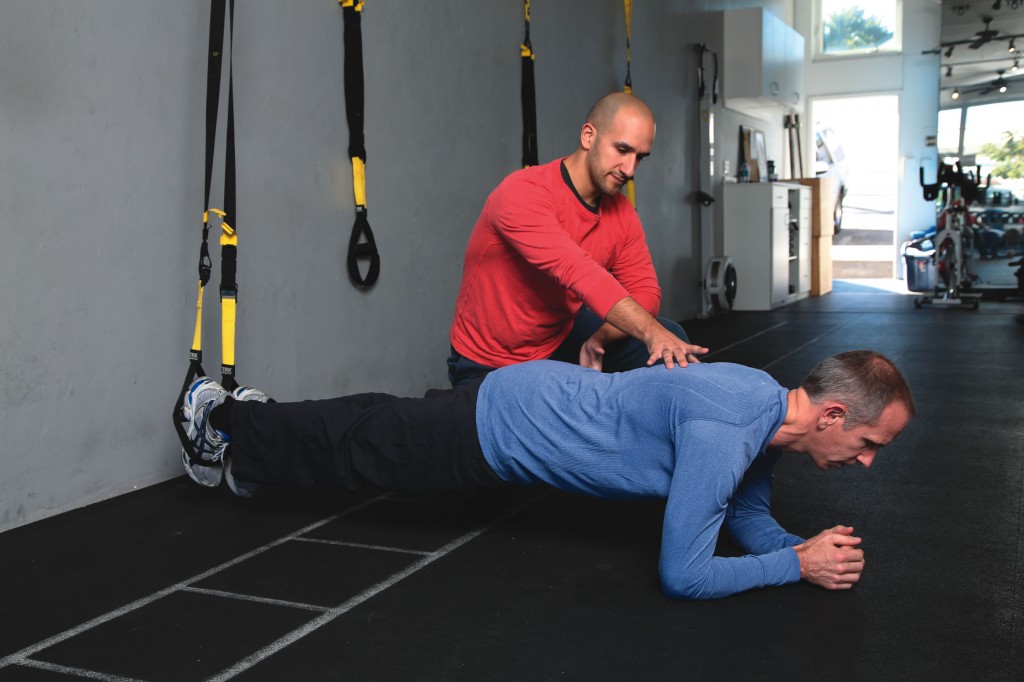

Regardless of the form the assessment takes—whether it’s at home or with a trainer—it’s essential for all men to develop a sense of their personal limitations to minimize the risk of injury while exercising.
Nothing Beats the Classics
The marvelous potential that comes with beginning a new exercise program is the variety of activities an individual can choose from to reach their desired physique. By integrating basic exercises into a workout, trainees can skip the expensive equipment, high-stress sets, dietary plans outside government guidelines and a considerably longer time investment that’s common in other trendy programs. Easy modifications also make it simple for men of all skill levels and stages of physical fitness to find a version that works for them.
For extreme beginners, Steve suggests modifying exercises as long as the correct form is maintained. When doing pushups, for example, you can start from the knees as long as the chest touches the ground.
“I like conducting full-body routines for several reasons,” Brian says. “[They’re] ideal for a person that does not have a lot of time—or does not want to spend a lot of time—working out in a fitness facility; [they’re] very efficient with time and effective with results; [and they’re] ideal for a person who is looking to body sculpt—rather than body build—while losing unwanted fat weight.”
Brian, who is wary of demanding programs that incorporate explosive movements, says that they may not be ideal for people with chronic injuries because of the impact they can have on the body. Instead, he encourages his clients to work across major muscle groups to strengthen the shoulders, chest, back, biceps, core and legs. Through a series of movements, including lifts, presses, pulls and curls, men are able to create a balanced regimen tailored to their own needs. Weights are determined by the client’s personal factors, and Brian increases the initial amount by 5 percent every few weeks, depending on the number of repetitions and sets completed in proper form. After clients maintain the correct technique, he transitions to adding dumbbell and barbell exercises to the program.
Whether working with a trainer or at home, every man’s routine should be based on ability and physical condition—in this case, Brian focuses on routines that provide a controlled range of motion with constant resistance for a balanced workout.
A Regimented Routine
Some men might opt for a more a cyclical regimen that allows time to be incorporated as a factor in working toward goals—something that helps to prevent boredom by varying the intensity and volume of the exercises across each phase. Periodization training, which Ryan incorporates as the third step of his program, can consist of a macrocycle (months to years of training), a mesocycle (weeks to months) or a microcycle (one to four weeks).
Ryan recommends a five-phase workout period, which incorporates basic core exercises such as static and dynamic stretches, jump rope, jumping jacks, hurdles, basic cone drills and sprints. Additionally, resistance training is developed through a variety of squats, dead lifts, pushups, rows, chest presses and weight lifting using barbells, dumbbells and kettlebells.
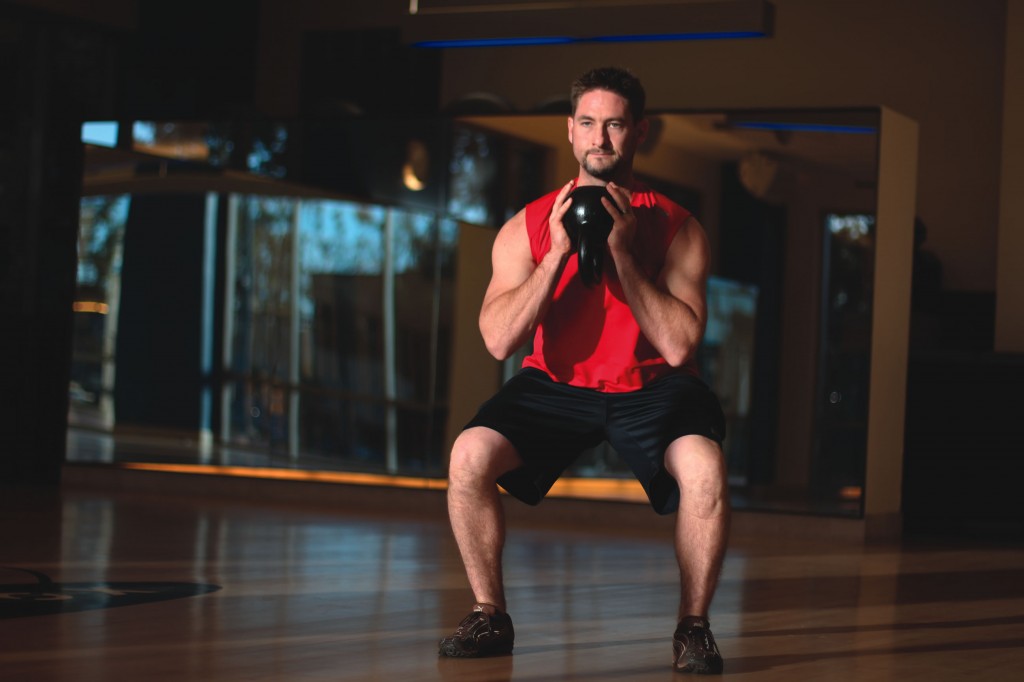
The system begins with an introductory phase (neuromuscular facilitation) that focuses on teaching basic moves and developing ideal movement patterns and posture—similar to conditioning. Phase two, muscular endurance, aims to build a resistance to fatigue by increasing the volume of the exercises but maintaining a low intensity. The third phase (hypertrophy) amps up the workout to build muscle and connective tissue by combining intensity and volume.
In order to produce or decelerate forceful movements quickly, the fourth segment strives to develop full body strength and coordinate the nervous system with the muscular system. Finally, phase five—the power phase—trains the body to transition movements with force quickly and prepares the body for a higher level of performance.
For those who want to keep it short and simple, Steve suggests a four-week program of bodyweight exercises, covering the full body in each day’s workout. As the weeks progress, not only should the duration of exercise be increased, but also other fitness factors such as the intensity and workout capacity. The ultimate goal is to allow the body to increase strength and fitness in not only the muscles, but also in the joints and connective tissues to help prevent injuries, he explains.
A typical first week might include two days of squats, pushups and crunches, and a quarter-mile run; two days of walking lunges, regular or assisted pullups and reverse crunches finished with two minutes of cardio on a bike, elliptical or StairMaster; and one day of a “cool-down” activity like yoga, in addition to two staggered days of rest. Each strength exercise is performed for one minute, then repeated for three rounds. For those with established bodyweight strength, Steve also suggests an intermediate series of additional squats, bench presses, pullups, overhead presses and deadlifts that would improve cardiovascular functions, core conditioning and strength training. The subsequent weeks might also incorporate different exercise combinations and workout orders for variety, such as one weight lifting set and one cardio set paired with 15 pushups and a one-minute sprint on a stationary bike.
Complemented by a healthy lifestyle—including proper nutrition—basic workout programs have proven to be beneficial and more popular with each passing year. They not only have provided healthy foundations for professional male athletes and those who just want to be fit and strong, but also for the trainers themselves, who have thrived on the programs they teach to their clients.
“In my own life, I have been able to overcome injuries and improve my fitness levels every year by sticking to the basic exercise concepts … and by adding in a variety of programming and pushing the levels of intensity,” Steve says. “I have found my fitness program has not only become more effective, but also more enjoyable.” NBM
Picture-Perfect Form
Fitness consultant Brian Keith Bias demonstrates the proper form for a burpee—a core exercise that targets a few major muscle groups, builds strength, burns fat and conditions.
From a standing position with feet shoulder-width apart, lower your body into a crouch (not shown) and kick your feet back to a pushup position. Arms should be bent to about 90 degrees at the elbows. Keep your body aligned straight from head to toe.
Return to a crouching position, with your body close to the ground and legs bent about 90 degrees at the knees. Place your hands on the ground in front of you with your elbows meeting the knees.
Springing off the balls of your feet, jump up—getting air—making sure to come down softly on the balls of your feet, followed by your heels touching the ground. Repeat in quick succession as your workout set requires.
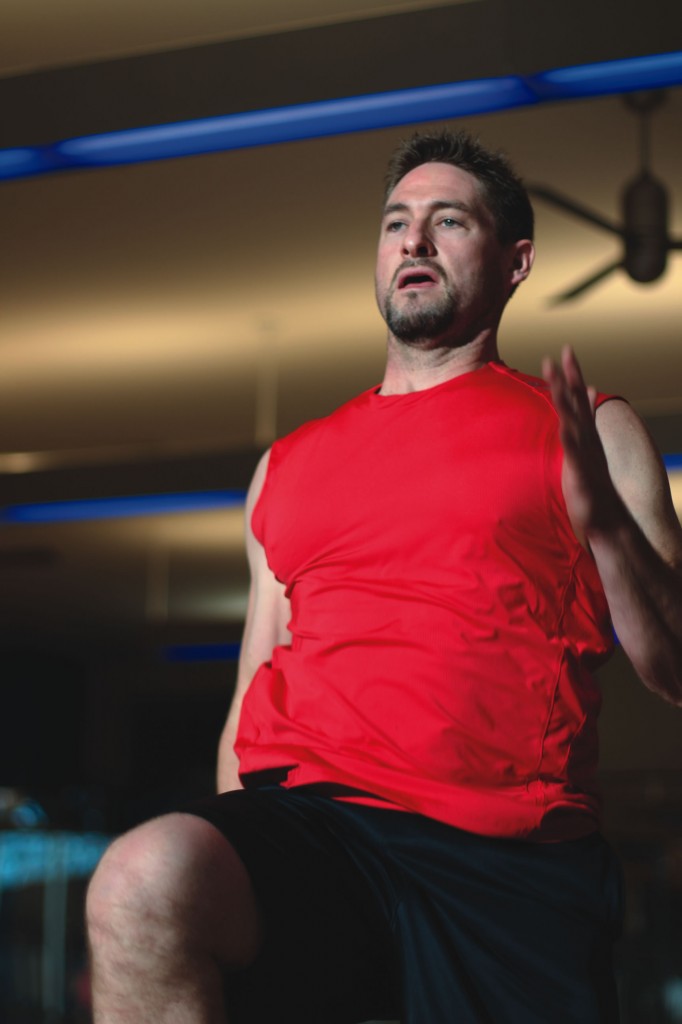 Power Hour
Power Hour
Busy executives can sweat out job-related stress with a quick lunchtime workout.
A mere hour for lunch doesn’t have to prevent a person from breaking a midday sweat. In fact, those 60 minutes are ample time to do a quick workout set to feel invigorated and refreshed for the rest of the day.
Personal trainer Steve de la Torre believes in the Tabata method, which calls for 20 seconds intervals of exercise and 10 seconds of rest. Beginners can do two sets each of squats, pushups, mountain climbers and burpees (a squat thrust), while those at the intermediate level can complete eight sets of a single exercise. This high-intensity, quick workout leaves the participant with more than half his break left to enjoy lunch.
Another time-oriented lunchtime activity is circuit training, recommended by Ryan Campbell, a physical trainer at Equinox Newport Beach, as an effective yet quick way to spend your lunch break. Known for working each section of the body in short bursts of cardio and strength training, circuit training typically involves switching between exercising muscle groups at a rapid pace. With repetitions and warm-up/cool-down periods, a lunchtime circuit workout can be completed with enough time to wash up and get back to work when the hour is up.
 Feeding the Machine
Feeding the Machine
The foundation for every workout is good nutrition. If a person in training doesn’t eat the right foods, then all his valued time and energy essentially results to nothing. Steve de la Torre, a Corona del Mar-based personal trainer, stresses the importance of consuming foods that are whole and naturally occurring.
“How do you know which foods are naturally occurring?” he asks. “Imagine if you were gathering and hunting for food in the wilderness—which foods would you find? You’d easily find vegetables, animal proteins, nuts, seeds and fruit, [but] you’d have a hard time finding macaroni and cheese.”
Steve explains that in order to make improvements in your daily diet, start by replacing processed foods with whole food choices, increasing your water intake to half of your weight in ounces, consuming protein at every meal and eating at least two large servings of greens daily.


